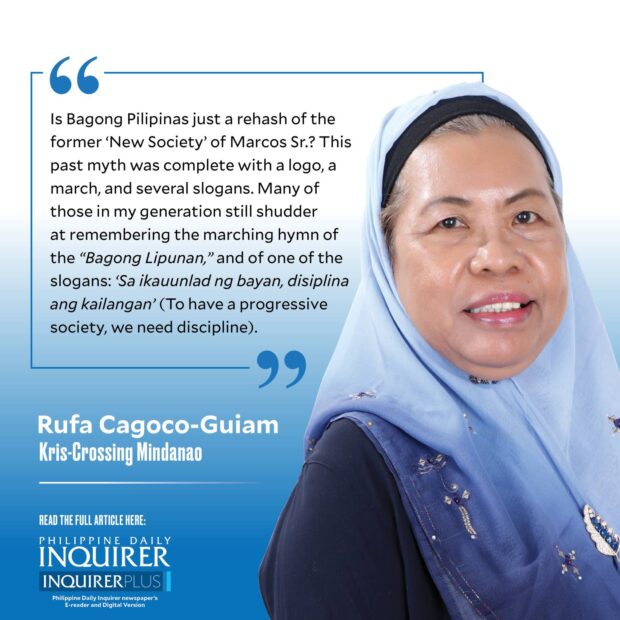Reifying a myth?
 It seems that President Marcos is going all out not only to dignify or cleanse the dark legacy of his namesake’s martial rule but also to carve out another myth-making regime, copying what his father did, reifying those past myths of a “New Society” (Bagong Lipunan).
It seems that President Marcos is going all out not only to dignify or cleanse the dark legacy of his namesake’s martial rule but also to carve out another myth-making regime, copying what his father did, reifying those past myths of a “New Society” (Bagong Lipunan).
Recently, television and print audiences have been exposed to bits and pieces of this new myth-making exercise of the Marcos II administration.
We start with the much-ballyhooed “Love the Philippines” campaign that earned an overwhelming volume of flak from both mainstream and social media. The audiovisual presentation that launched the Department of Tourism’s (DOT) campaign included stock footage of scenes that are not from the Philippines, evidence of the public relations firm’s sloppiness and indolence to come up with such a controversial video. Or is it because this administration is jealous of other countries in Southeast Asia that have the highest tourism revenues in the region? (Now that this ad campaign has become the eye of the storm in media circles, DOT Secretary Christina Frasco is reportedly on “family leave,” prompting witty social media users to poke fun at her, telling her to “Leave the Philippines”—for good.)
Or is it this administration’s way of creating another myth of a beautiful Philippines, using the scenic locations of other countries, which have been the favorite destinations of many tourists?
Then there was the new logo of the Philippine Amusement and Gaming Corp. (Pagcor). The new management of the board decided to adopt a new logo that looks more like a poor imitation of an abstract art piece painted by masters like Pablo Picasso. It is so abstract, just brushes of red and blue and a little yellow, seemingly appearing like a flame or something else that perhaps only the designer knows what it means. Even television anchors heckled whoever designed it.
Just a few days ago, Mr. Marcos announced that he is going to create a “new brand of governance” and voila, such conception is accompanied by another logo.
Could it be that the designer of the new Pagcor logo and that of the “Bagong Pilipinas” is one and the same? Except for the seal of the Philippine government, it also has curved brushes of red and blue interspersed one after the other, under the seal. Just like the more abstract new logo of Pagcor.
Is Bagong Pilipinas just a rehash of the former “New Society” of Marcos Sr.? This past myth was complete with a logo, a march, and several slogans. Many of those in my generation still shudder at remembering the marching hymn of the “Bagong Lipunan,” and of one of the slogans: “Sa ikauunlad ng bayan, disiplina ang kailangan” (To have a progressive society, we need discipline).
At that time, many of us who were still in our late teens questioned, “Who needs the discipline?” And what kind was it? Then we just realized that discipline meant being silent in the face of all the violations of human rights done right before many of us by the martial law agents of Marcos Sr. Some friends and acquaintances, especially those who stood up against this imposition of the iron hand rule by the former dictator, were either tortured to death or harassed no end. Many women were raped or molested by military forces.
There were also emblematic cases like the massacre of more than a thousand men in Barangay Malisbong, Palimbang town in Sultan Kudarat on Sept. 24, 1974. Let us not forget the burning of the town of Jolo, the capital town of Sulu province, that took place on Feb. 7, 1974. It capped several days of intense firefights between the forces of the Philippine military and those of the Moro National Liberation Front.
So what are the elements of this new “brand of governance” that Mr. Marcos is touting about? Will this be another myth to appear like a real deal, when we are all seeing just a film remake of his father’s “Bagong Lipunan”? We should brace ourselves for what it will entail in the near future.
—————–
Comments to rcguiam@gmail.com




















